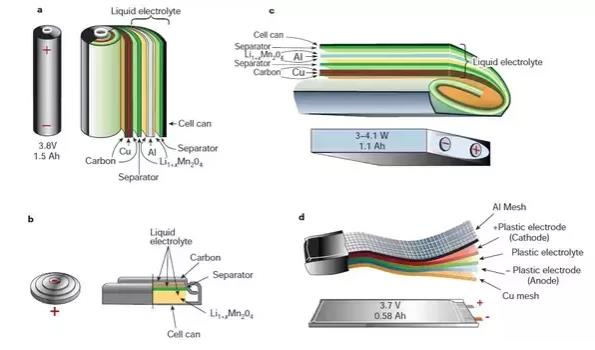1. Material
Lithium ion batteries use liquid electrolytes, while polymer lithium batteries use gel electrolytes and solid electrolytes. In fact, a polymer battery cannot really be called a polymer lithium battery. It cannot be a real solid state. It is more accurate to call it a battery without flowable liquid.
2. Packaging method and appearance
The polymer lithium battery is encapsulated with aluminum-plastic film, and the shape can be customized at will, thick or thin, large or small.
Lithium-ion batteries are packaged in a steel case, and the most common shape is cylindrical, the most common is 18650, which refers to 18mm in diameter and 65mm in height. The shape is fixed. Can’t change at will.
3. Security
There is no flowing liquid inside the polymer battery, and it will not leak. When the internal temperature is high, the aluminum-plastic film shell is just flatulence or bulging and will not explode. The safety is higher than that of lithium-ion batteries. Of course, this is not absolute. If the polymer lithium battery has a very large instantaneous current and a short circuit occurs, the battery will ignite or explode. The battery explosion of Samsung’s mobile phone a few years ago and the recall of Lenovo laptops due to battery defects this year are the same problems.
4. Energy density
The capacity of a general 18650 battery can reach about 2200mAh, so that the energy density is about 500Wh/L, while the energy density of polymer batteries is currently close to 600Wh/L.
5. Battery voltage
Because polymer batteries use high-molecular materials, they can be made into a multi-layer combination in the cells to achieve high voltage, while the nominal capacity of lithium-ion battery cells is 3.6V. In order to achieve high voltage in actual use, more Only a series of batteries can form an ideal high-voltage working platform.
6. Price
Generally, polymer lithium batteries of the same capacity are more expensive than lithium ion batteries. But it cannot be said that this is the disadvantage of polymer batteries.
At present, in the field of consumer electronics, such as notebooks and mobile power supplies, more and more polymer lithium batteries are used instead of lithium ion batteries.
In a small battery compartment, to achieve the maximum energy density in a limited space, polymer lithium batteries are still used. Because of the fixed shape of the lithium-ion battery, it cannot be customized according to the customer’s design.
However, there is no uniform standard size for polymer batteries, which in turn has become a disadvantage in some respects. For example, Tesla Motors uses a battery composed of more than 7000 18650 sections in series and parallel, plus a power control system.
Post time: Oct-29-2020







